Halo Infinite on Xbox Series X
For the past four or five years, Microsoft has been attempting to close the gap with Sony when it comes to cinematic, AAA experiences. PlayStation has become synonymous with third-person, story-driven games that take players on epic journeys across frost-bitten mythological lands and immersive historical settings, while Microsoft’s studios have struggled to reach the same dizzying highs. Halo Infinite, however, marks a turning point in this narrative — not quite an all-conquering great, but certainly a sign that Microsoft has started to find its footing when it comes to evolving its iconic franchises with new, exciting design. Infinite’s incredible production value, which marries cutting-edge visuals to simply sublime gameplay, pushes forward a movement kickstarted by Gears 5 back in 2019.
Importantly for Halo fans, it’s a clear indication that 343 Industries has been listening to fan feedback following the divisive Halo 5 and, more recently that iffy gameplay trailer from last year. Combining another epic adventure with everyone’s favorite gruff-voiced Spartan, Master Chief, with a refined but still hectic multiplayer mode, Halo Infinite is a return to form and one you absolutely cannot miss out on.
Halo Infinite offers up two distinct experiences — one a lengthy adventure with Master Chief in its campaign, and the other a chaotic arena shooter multiplayer experience. For the sake of clarity, this review will be covering both under clear headings, and both parts of the game will play a part in determining the game’s final score at the bottom of this review.
Campaign
Halo Infinite’s campaign is where the most noticeable advancements for the series can be seen. Set approximately 18 months after the events of Halo 5 — which was a largely Master Chief-less experience — Halo Infinite puts us firmly back into the iconic green Spartan armor of the Chief as he aims to discover what actually happened to Cortana, all the while stopping the Banished from seizing total control of the Zeta Halo before it’s too late.
While I’m going to avoid diving too much into the story beats to save you all the twists, turns, and revelations that it offers up fans along the way, I will say it’s gripping and kept me hooked throughout the 20 hours or so I spent on Zeta Halo to write this review. What’s most noticeable is how this feels like a more emotional look through the visor of Master Chief. There’s more range in this super-soldier than the brief, gruff-voiced lines he’d occasionally mutter in previous titles. He wrestles with his past regrets and decisions and how these failings have led him to where he is.
Accompanying Chief along the way is The Weapon, an immediately likable AI with a chirpy and charismatic persona that juxtaposes with John’s steely personality perfectly. The two soon grow close, providing plenty of comic relief, something I hadn’t expected to get out of Halo Infinite outside of its true-to-form Grunts that can often be heard screeching things like “It’s the big green man!” or “he’s definitely here… unless he’s right behind me… AHHH!”
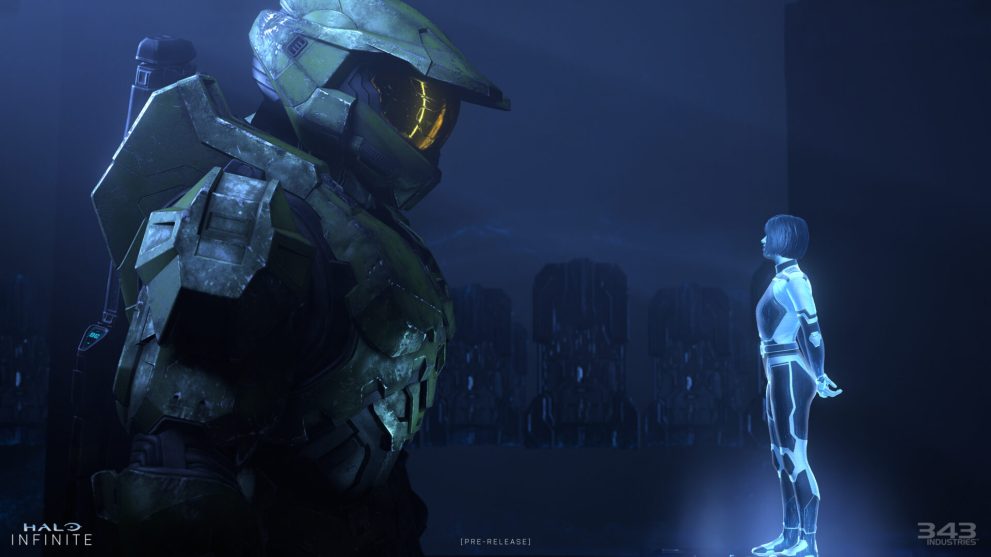
But The Weapon also provides Master Chief the moments to engage with his inner feelings. It makes for a formidable partnership when you’re busy jumping your way through story missions and around Zeta Halo on a broader scale.
The big bad antagonist in Escharum is equally fleshed out, with cutscenes suitably explaining his plight and audio logs flesh things out on the Banished side suitably. Finally, there’s the pilot, often referred to as Echo-216 — his ship’s name. Though not given as much screen-time he’s a likable enough character, often questioning MC’s gung-ho approach with panicked comments or heated outbursts, providing an average human’s rather bleak outlook on our protagonist’s perilous missions.
All of this makes for a more rounded Halo experience. Personally, I always found the world of Halo fascinating, but the stories in some of Chief’s past adventures are two-dimensional. They seldom offer the opportunity to get a real look at the man inside the imposing armor. Infinite does this, making Chief feel more human, and thus more relatable. Master Chief’s armor and combat skills may be inhuman, but he still has the feelings, thoughts, and regrets that we all have to comprehend and come to terms with.
The broader story focuses on Master Chief’s mission to put an end to the Banished’s reign on Zeta Halo once and for all. Yes, you’ll get answers to plenty of other questions along the way — you’ll have to play for yourself to learn those — but the driving force behind the Chief’s exploration of Zeta Halo is the objective of reclaiming the ring from the enemy before it’s too late.
It’s this overarching story beat that helps provide logical context to Halo Infinite’s adoption of open-world design. The game flits between linear story missions and its open world, allowing players to take on optional side content such as High-Value Targets, capturing enemy bases, or picking up collectibles scattered throughout the world.
As you complete a mission, you move around Zeta Halo into new areas that were previously inaccessible. The act of rescuing some UNSC soldiers from Banished forces, or taking down a High-Value Target in a remote part of the world all makes sense because the Banished are busy occupying and defending the ring while Escharum is busy trying to unlock its inner secrets, and Master Chief is, more or less, the sole aggressor who can turn the tide of battle.
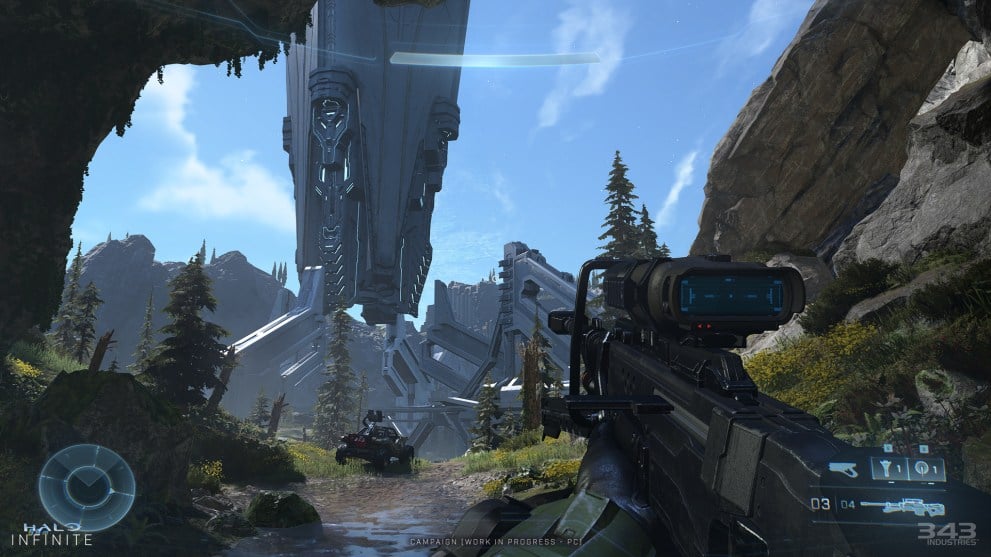
The open world of Zeta Halo gives a real sense of scale to Master Chief’s mission to reclaim it, and it looks stunning throughout. A dramatic landscape of a myriad of towering mountain peaks, laced with futuristic, metallic hexagonal pillars stretching their length, punctuated with large pine trees and rolling green pastures.
Hidden camps of former Spartans can be found tucked away in a tight-packed cluster of trees, or at a vantage point on the side of a mountain, sniper rifle aiming down into a camp of Banished below. Banished Propaganda Towers spout the comical ramblings of some high-level Grunt, while audio logs littered throughout the world provide more context for everything you’re seeing and doing. Enormous alien monolith-looking structures rise out of the ground, indicating something of interest to you may be hiding underneath.
All of this goes to make a world that’s intriguing, and one that encouraged me to put down Chief’s grappling hook — albeit briefly — to explore on-foot and unearth new discoveries. But actually, it was in doing this that Zeta Halo’s drawback became clear. What is here is fantastic, but it’s ultimately limited in terms of its quantity and the ambition of its side content.
Amidst the various Banished bases and outposts, there’s not a whole lot to see. The map eventually becomes littered with icons, but many of these are Mjolnir Armories — a type of collectible that unlocks multiplayer cosmetics — and Spartan Cores used to upgrade your various abilities like your Shields, Grappling Hook, and Thrusters.
Finding these often requires little more than heading to the location marked on your map, defeating a handful of enemies, and picking them up. It’s basic open-world stuff, and while it’s all well and good being included, I had hoped for some more in-depth side missions to accompany these.
The most obvious means of doing so would have been the various weapons and vehicles you unlock to be requested from a FOB (Forward Operating Base) by earning Valor, a cumulative currency earned by rescuing UNSC Squadrons, completing main missions, and clearing out enemy bases.
Earn enough Valor and you’ll unlock a new weapon or vehicle from a rail-like progression system not dissimilar to a Battle Pass. It’s fine, and unlocking more powerful weapons and vehicles provides a nice sense of progression in your reclamation of Zeta Halo, but could have made a little more sense had there been more attention to detail.
For example, what if an individual UNSC marine needed Master Chief’s help reclaiming their sniper which they had left at a vantage point now surrounded by Banished, and we had to go fetch it to unlock it from the FOBs? Or what about a series of grizzly marine remains being found and the Chief had to track down a particular High-Value Target somewhere in the map, with a breadcrumb trail of clues leading to their hidden location? What about heading out on a Warthog, blowing up all manner of Banished structures, turrets, and vehicles with some Marine buddies to help them reclaim a major base or stronghold?
These are just a handful of ideas off the top of my head that could have made for more immersive, engaging side content in Halo Infinite. Instead, what you’re left with is perfectly fun enough as a distraction, but falls short of the excellent world-building and storytelling that the main story missions provide.
Over my 20-ish hours on Zeta Halo, I swung back and forth with how I felt about its open-world. At times, I was awe-inspired by the views from its towering mountain tops and the thoroughly enjoyable Banished bases to capture, while during other moments I was left disappointed by how underbaked elements of its design feel. Halo Infinite is in many ways the next evolution of Microsoft’s, cinematic AAA format, but it isn’t innovative enough to make it a revolution in open-world design.
Don’t get me wrong, Halo Infinite is better for being an open-world game. That was clear after I took out a High-Value Target from across the other side of an enormous canyon, picking off their panicking grunt cohorts with a sniper. It’s Halo on a scale you’ve never experienced before, and when it works, the open-world truly shines.
But there was room for so much more to be done here and compared with other open-world titles today, it’s a little too Far Cry-like in design. A checklist-y splattering of stuff to do across a beautiful blend of futuristic alien structures and serene greens and muddy browns of mother nature that make up Zeta Halo.
It’s a step forward for Halo, sure, but it’s not in terms of general open-world gameplay or design. I don’t think it’s necessarily meant to be, given the level of polish and grandiose nature of each of the main story missions. Not to mention the fact that you can just ignore the open-world content entirely.
It’s Master Chief’s story that you’re really playing for. The open-world is there to offer you a selection of Halo-themed, open-world accouterments that are pleasant enough, but don’t offer the same bang for your buck as the main story missions, should you choose to indulge. For Halo’s big open-world debut, I had hoped for a bit more.
What does make Zeta Halo a joy to explore, however, is Master Chief’s newest toy, the Grappling Hook. Not only does this allow for some new approaches to combat — yanking a Jackal’s shield out of their hands, or hurtling through the area to stun an enemy with one of Chief’s steel-clad fists never gets old — it makes traversing the steep, mountainous terrain of Zeta Halo an absolute blast.
It actively encourages you to see where you can go and what’s possible with it. It feels almost Spider-Man-like, especially once you’ve unlocked all of its upgrades and can chain together swings from tree to tree, or literally flinging yourself up a cliff-face thanks to the satisfying flick of propulsion you get at the end of each ‘pull’ flinging you into the air, giving your hook time to recharge and flick you even further up.
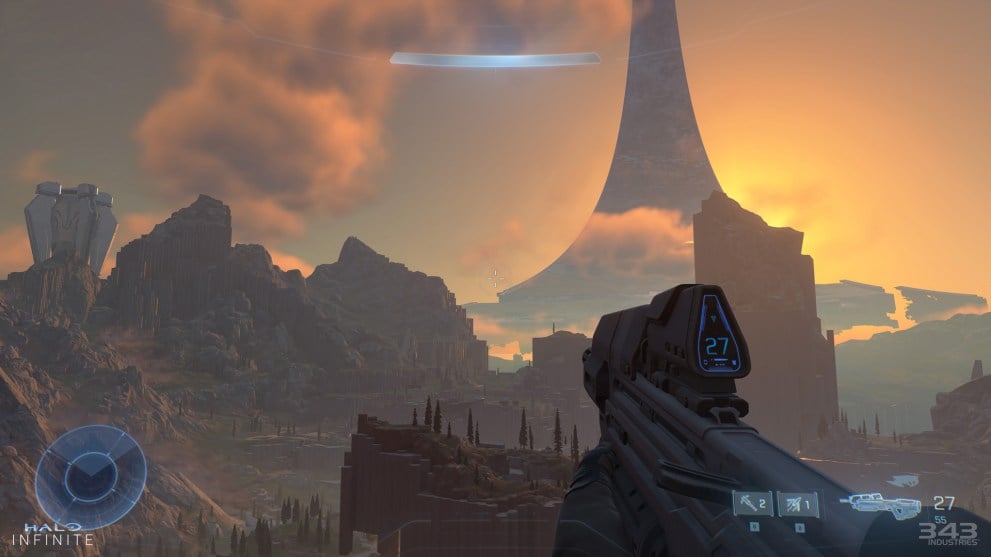
Alongside the Grappling Hook, Master Chief also gets access to a number of other abilities throughout his adventure, but none of it is quite as exciting or satisfying to use as Chief’s web… I mean hook. Deployable cover and thrusters have some use in combat but aren’t anything overly exciting or groundbreaking.
As such, I found myself barely changing between Chief’s equipment, only doing so when particular combat scenarios called for it. Upgrading your abilities does offer up some more interesting uses and mechanics — such as the ability to be briefly cloaked while using the Thrusters — but once I’d fully upgraded my Shields and Grappling Hooks, I was less driven to seek out the remaining Spartan Cores littered throughout the world used to upgrade them.
The two parts of Halo Infinite’s campaign — the open-world content and more linear story missions — have one thing in common, though: they’re wrapped up in absolutely spectacular gameplay that just makes every combat encounter a blast. Master Chief feels suitably powerful, and the arsenal of weaponry at your disposal handle in distinctly unique ways.
It’s the same floaty-controlled movement and tight gunplay that’s become synonymous with the Halo series. A BR’s sharp, controller burst fire, for example, is perfect for picking off enemies from afar, while shotguns feel appropriately punchy and pistols remain a staple of any loadout with their mid-range effectiveness.
Enemies feel like they’ve been given an overhaul in Halo Infinite. Suicide Grunts still charge at you, Plasma Grenade in each hand, yelling manically in the process, but they’re joined by new enemy behaviors. A melee-type Brute charges at you relentlessly and at pace, requiring expert aim to dispatch of them before they beat you to a pulp, while Jackals constantly search for cover, peering out and picking you off with a sniper at the most inopportune time.
Other Brutes wield power weapons, peppering you with artillery blasts, plasma projectiles, or RPGs, while standard Grunts often group together in numbers to pepper you with Plasma Pistol shots before, as usual, fleeing, cowardly holding their hands up in the air as they scream about your encroachment.
All of this makes for combat scenarios that feel frantic and chaotic. You’re forced to prioritize taking out different enemies to push forward, lest you be sent to your untimely demise by a swift sniper shot from the Jackal in a vantage point above you.
It’s this fantastic gunplay that helps carry Halo Infinite’s campaign’s weaker moments. The basic side content around the open world remains fun because going about blasting the Banished to smithereens is so satisfying, and each one offers up a new opportunity to try out a different approach or to use one of those unique weapon variants obtained by defeating a High-Value Target.
The whole thing runs for the most part at a silky smooth framerate at 4K, which makes particle effects from explosions look fantastic and the action feels suitably fast-paced. That being said, I did stumble upon a number of strange technical issues, the most noticeable of which occurred on three separate occasions in different skirmishes with the Banished.
The game completely froze up for 5-6 seconds, before resuming as if nothing happened. In other, less detrimental moments, my UNSC marine buddies would dive to the floor in cover, before clambering back to their feet and repeating the animation over and over again… when there were no enemies in sight. There were also some strange graphical artifacts popping up in the sky which were a little distracting and immersion-breaking, but this is something I’d expect to be buffed out with a day-one patch.
Halo Infinite’s campaign is the leap of faith Master Chief needed to take into the open-world. Having free reign in Zeta Halo felt freeing, finally escaping the confined corridors, intimidating alien halls, and mere sandbox outdoor areas from past entries in the series. Its side content is a little limited in its offering though, both in terms of quantity and its ambition, but ultimately provides a fun distraction with some lucrative rewards for both the rest of your campaign with Master Chief and the accompanying multiplayer via its Mjolnir Armories, alongside the usual progression abilities and unlocks.
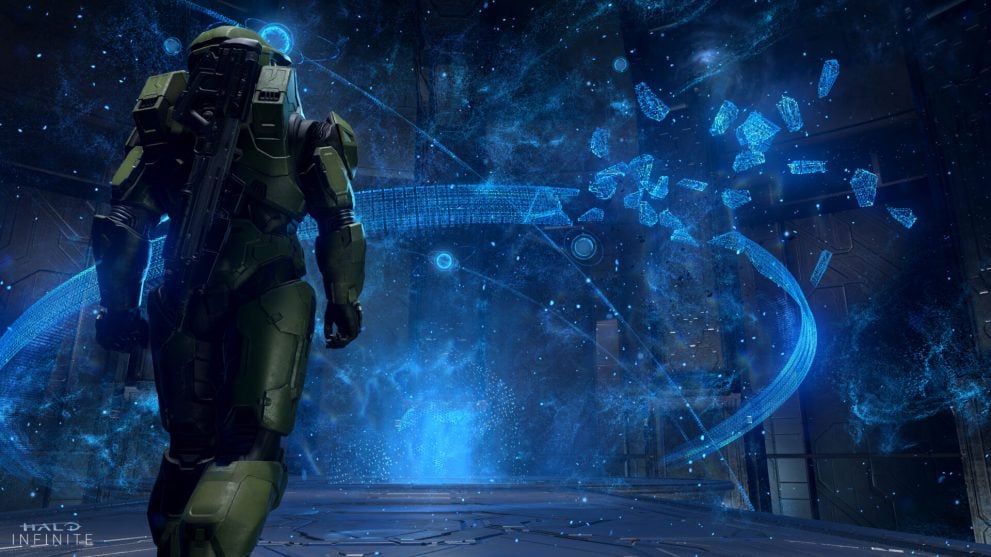
That being said, the campaign was still one of the most enjoyable single-player experiences I’ve had all year, thanks to its consistently strong story missions. The Cortana mystery and threat of the Banished provide a story that kept me hooked throughout, teasing revelations, twists, and turns and opened Master Chief up to a more emotive relationship with his AI buddy and those around him.
Infinite’s gunplay is sublime and the world-building attempted through the open world of Zeta Halo is strong where it’s present. Despite having just finished this fight, I’m already desperate to start MC’s latest adventure all over again in co-op with friends, grabbing all of the incredibly well-hidden skulls along the way. Unfortunately, co-op won’t be available until sometime next year, but at least there’s the multiplayer to enjoy in the meantime.
Multiplayer
By the time this review goes live, Halo Infinite’s multiplayer will have been publicly available for three weeks in what’s being called an ‘early access’ period. This is what I’m basing my review of Infinite’s multiplayer, and it should be noted here that future ‘Seasons’ in the game may address some of my initial concerns.
For the first time in the series’ history, multiplayer is completely free-to-play, regardless of whether you’ve purchased the campaign or not. This allows more people than ever to hop into the chaotic, arena shooter multiplayer than ever before, and should hopefully ensure that the serves remain well populated for years to come, even in a highly competitive multiplayer landscape as we’re in today.
From the get-go, Infinite’s multiplayer feels very traditionally ‘Halo.’ It’s put away the game mode gimmicks and class load-outs of its previous two entries and instead focused on an enthralling mix of exceptional map design, a well-balanced arsenal of weapons and vehicles, and fan-favorite game modes to keep players grinding out those wins.
At the time of writing, there are 10 maps in Infinite’s multiplayer, though some of these are only available in Big Team Battle (BTB) which pits teams of 12 against one another, as opposed to the more tactical 4v4 skirmishes you’ll get in Arena.
This does feel a little light, particularly if you’re a fan of BTB as there are only three maps available in this mode. More maps should follow in the coming months and years in line with new ‘Seasons,’ though no official announcement on when a new map or two will first arrive in Halo Infinite.
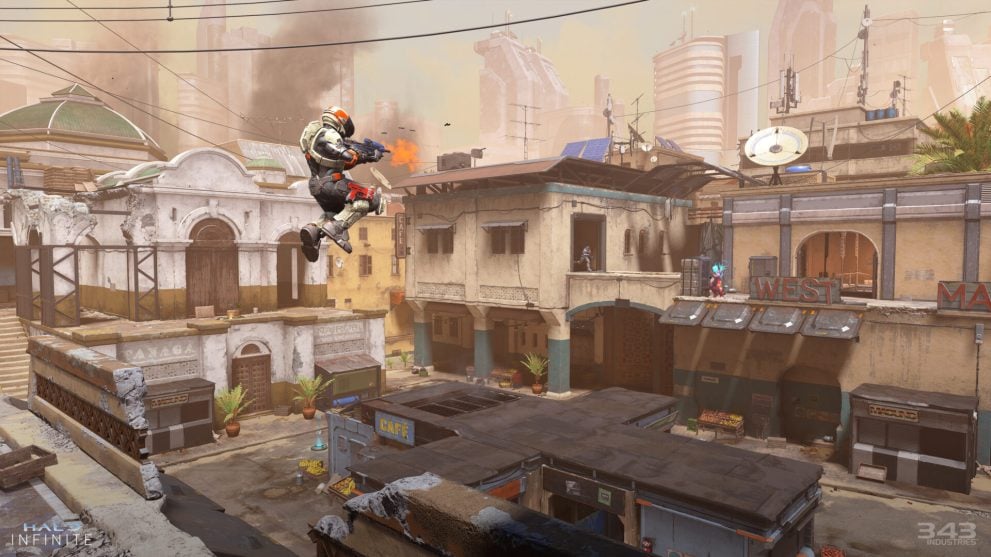
Fortunately, the maps on offer here are excellent. The smaller ‘Arena’ maps adopt a familiar three-lane approach, forcing players into engaging the enemy both in close-quarters combat or at range with a sniper or rifle. There are suitable amounts of cover worked into the design of the maps, too, which forces snipers to be clever about their sightlines, and gives those who like to go in all-guns-blazing a chance of weaving their way closer to their enemies.
The larger BTB maps are the sandboxes for all-out-chaos. Enemies and teammates will duke it out in Banshees in the skies above, while Warthogs and Ghosts splatter unsuspecting opponents. Skewer (think sniper with a giant spear as ammo) shots hurtle through the air, pinning the corpses of their targets to walls and floors, and frantic melee matches can be seen in every direction you look around the map. These feel far grander in scale, as you’d expect, while still managing to force engagement between the two teams.
Snipers will still find ample hidden spots to set up camp, while runners will soon learn the best paths to make their way to the middle of the conflict without being picked off. Power weapon spawn points offer up invaluable rewards for those that reign victorious from the duels that play out over them. It’s classic, chaotic Halo.
Outside of the chaos of BTB, there’s also the Quick Play and Ranked Play options. These are both 4v4 modes, and see you playing modes such as Slayer, Oddball, Strongholds and Capture the Flag (CTF). It’s here where one of my chief complaints with Infinite’s multiplayer lies.
There simply aren’t enough game modes or playlists available right now. Particularly notable is the lack of fan-favorite game modes like Team SWAT, Lone Wolves, and Griffball. Compounding the game mode woes further are the lack of playlists, or the ability to toggle which modes you’d like to matchmake for. Right now, you can simply search for either Quick Play or Ranked Play, but you can’t choose which modes you want to play.
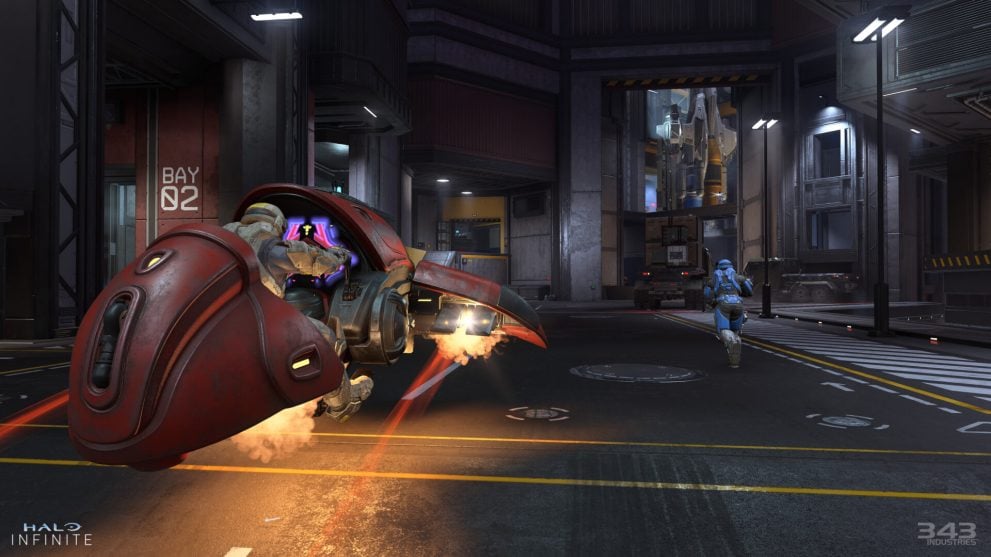
This is less an issue in Ranked Play but is particularly frustrating in Quick Play, where a majority of the time you’ll be paired up with strangers who have no intention of playing the objective despite playing a game mode like Oddball or Capture the Flag, forcing you to endure a game you’ll inevitably lose. It resulted in me growing frustrated and fatigued with the multiplayer in some of my sessions more so than I expected and is one of the issues with Infinite’s multiplayer I’d like to see rectified as soon as possible.
Of course, nowadays, having excellent multiplayer gameplay isn’t enough if you don’t have a compelling progression system, and this is another area where Halo Infinite’s stumbled in its ‘early access’ period. Mirroring many of the competition, Infinite has adopted a Battle Pass system for players to track their progression. Completing challenges earns XP which levels up your Battle Pass, earning various cosmetics along the way.
It’s a tried and tested system, except for the fact that 343 Industries, has restricted the XP that levels up your Battle Pass just to these challenges. This has been tweaked slightly in the past week or two, with players now earning XP for each game they play — 300 XP for their first game each day, dropping by 50 XP per game thereafter, until game seven and onwards where 50 XP is earned — alongside any other challenges they complete, such as getting 15 kills with the BR or saving an ally from across the map with a long-range shot.
From my time playing Infinite since, this has resulted in Battle Pass progression feeling far less grindy and more rewarding, but it still requires a fairly significant time commitment to reach Tier 100, which I always find a little fickle given you’ve already ‘paid’ for the premium Battle Pass.
A multiplayer shooter can only be as good as its arsenal of weapons, though, and thankfully Infinite retains some fan-favorites to balance out a number of dud additions and frankly questionable changes to existing classics like the shotgun and Pulse Carbine.
The BR remains a headshot hunter’s best friend with tight accuracy and hefty stopping power, while the Sniper and Skewer are quite possibly the most satisfying weapons to use in the game, period. Then there are the duds, the Plasma Pistol still doesn’t feel like a viable option, while changes to how ‘punchy’ the shotgun feels in the multiplayer result in a wall weapon don’t feel as powerful or effective as it really should.
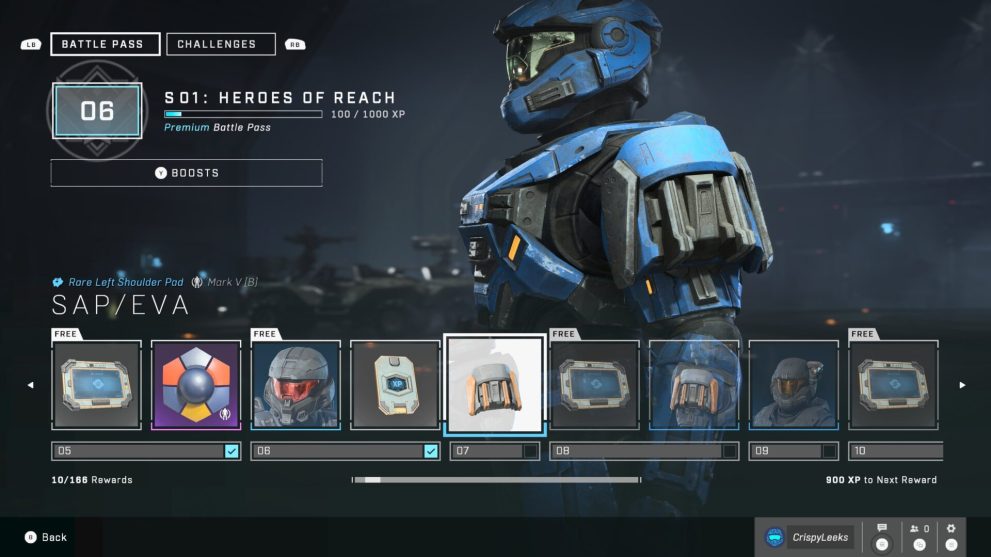
The final pillar of Halo Infinite’s multiplayer comes in its new ‘Events.’ The first of these was the Fractures: Tenrai event which saw the ‘Fiesta’ game mode make its way into the rotation, taking the rules of Slayer and throwing in random weapons and abilities each time you die and respawn. Fiesta-specific challenges were added onto our list, and completing these unlocked more cosmetics and rewards off an event-specific Battle Pass, the main attraction here being some fancy Yoroi samura-inspired armor.
In principle, these events have all the right components to make for a compelling reason to return to Halo Infinite each season, but the way it’s been executed in this first instance was a little disappointing. Completing the event-specific Battle Pass requires players to grind out almost all of the event challenges in each of its four different weeks it’ll be live throughout the current Season. That again requires a massive time commitment, given these event-specific challenges are mixed into your standard weekly challenge list and so aren’t all active immediately.
Again, this is something that 343 Industries can alter for future events, and would go a long way in resolving current feedback on the multiplayer.
Halo Infinite’s multiplayer feels familiar. It’s got the same core components that made me fall in love with Halo 3’s multiplayer all those years ago, spending hundreds of hours in both public matchmaking and custom games lobbies with friends. Its maps, while limited in quantity, are of exceptional quality, and the arsenal of weapons provides enough fan-favorites and impressive new additions to balance out the duds. Seriously, what happened to the shotgun and carbine?
With 343 Industries pledging to support the game through various seasons with new cosmetic items and maps, Infinite’s multiplayer has everything it needs to become an Xbox Live staple once more, just as long as 343 Industries irons out some of these ‘early access’ kinks.
Halo Infinite is a strong package, offering exceptional story missions in a campaign with an underutilized open-world, and compelling, chaotic multiplayer. Its campaign offers yet another unmissable adventure with the Master Chief, giving us a glimpse at a more emotional man inside the armor. The world of Zeta Halo is a solid foundation for the series’ open-world format, but its side content is basic and there’s not a massive amount of it, leaving it feeling a little bit of an afterthought, despite how well the narrative fits the design.
It’s a step forward for the series but does nothing groundbreaking in terms of industry standards. Fortunately, the combat gameplay remains some of the most enjoyable in games right now. The lack of co-op campaign at launch is a little disappointing, but the promise of its release in 2022 will give players all the more reason to reclaim Zeta Halo from the Banished all over again.
For now, the classic Halo multiplayer offering will be more than enough to keep them playing for months on end, even if the game modes and maps offering needs some refinement, ideally sooner rather than later. This is the evolution the series needed and provides a promising foundation for the future of the series.
Pros
Cons
Potential for more to be done with side content and Zeta Halo
Some minor performance issues
No co-op campaign at launch
Some map and game mode issues are present in the ‘early access’ multiplayer
